第二节知识储备
一、名词在句子中的作用
名词在句子中有以下几种重要作用,如做主语、宾语、表语、补足语等。它是句子中最主要的词。
(一)主语
1.句子的主语:
Father is working on the farm./Mary visited her teacher yesterday./A beautiful ship will sail on this river tomorrow./Some goods have arrived.
句子中的黑体字均表示“谁……”或“什么……”,即动作的执行者。一般都放在句首。
2.动名词逻辑上的主语:
They thought Tom’s going there a mistake./M ary’s getting married will be announced next month.
句子中的黑体字均为动名词逻辑上的主语,表示动名词going,getting的执行者。
3.分词上的逻辑主语:
Peter being ill,his mother has to stay at home./ The sun having set,children went home./She came into the classroom,her face covered with sweat.
句子中的黑体字均为分词上的逻辑主语,表示这是“谁”的情况,如Peter生病、太阳落山等。
(二)宾语
He has a pretty cat./Teacher can help Rose./The sailor crossed the dangerous river easily./Students should do their homework alone.
句子中的黑体字均表示动作的承受者,通常放在及物动词的后面。
She gave John a bag./ The grandmother is telling children a story./ The little boy brought mother an orange./The wife cooked her husband a big fish.
句子中的黑体字均为双宾动词的宾语,其中,指人的为间接宾语,如John,mother等;指物的为间接宾语,如bag,fish等。
以下是介词的宾语:
I went to school everyday./They are talking about the traffic accident./On Friday,we always have our English lessons.
句子中的黑体字均为介词的宾语,表示与介词有关的东西,和介词一起表达一个完整的意思。这种宾语一般跟在介词后,和介词一起构成介词短语。
(三)表语
My sister is a doctor./ He has become an artist./ The ruins have been a famous building.
句子中的黑体字均为表语,表示主语是“谁”、“成为什么”。主语和其补足语往往指同一个人或同样东西。句子的动词为系动词。
(四)宾语的补足语
Many people now consider the family a school./They elected him president./All the students in that class knew their monitor a coward.
句子中的黑体字均为宾语补足语,对宾语进行补充说明,表示它“成为什么”、“被认为如何”等。它和宾语有密切关系,通常紧跟宾语其后。
(五)状语
He will arrive here next week./We have walked eight miles./ It is six inches./He will be back Monday.
句子中的黑体字均为状语,这些状语用来修饰动词或形容词,表长度时间等。在多种情况下,其前面有修饰语,有时也可以单独做状语。
(六)同位语
My friend John is a pleasant person./This is Mr.Smith,headmaster of No.3 Middle School./My roommate bought many things:books,pencils and stamps.
句子中的黑体字均为同位语,表示其前面名词或代词究竟指什么,或对其前面的名词或代词做补充说明,如John,headmaster,和books,pencils and stamps分别对friend,Mr.Smith,things做进一步的说明。
(七)定语
My family lives in a country house./They are at the harvest festival./He often visits night club./His uncle met a silver smith that day.
句子中的黑体字均为定语,修饰其后面的另一个名词,或与另一个名词构成合成词。
二、名词的数
(一)可数名词
可数名词有单数形式和复数形式。在句子中,名词的单数前面要有冠词或表示单数的限定词,否则就要用其复数形式。但如果名词前面已有表示单数的冠词或表示单数的限定词,就不能再用其复数形式。
例1:Encyclopedias may be used to answer questions,to solve problems or to obtain information on a particular topic.
此例中用question的复数形式来泛指“用来回答的问题”,同时使用复数形式也是为了与“problems”和“information”平行。若用单数形式,则在question前必须有a或者the。句意为:百科全书是用来回答问题、解决困难和获得某个特定题目的信息的。
例2:Thomas Jefferson skillfully organized his supporters in congress into a strong political group.
此例中a与group相呼应,句意为:托马斯·杰斐逊很精明地将他在国会中的支持者组成了一个强有力的政治团体。
(二)可数名词的复数形式
英语的可数名词有单数与复数两种形式。单数表示“一”或“少于一”,复数表示“多于一”。复数形式通常是在单数名词后面加上词尾-s(-es)构成,还有一部分名词则有不规则的复数变化形式。
名词复数变化一般规则如下表:
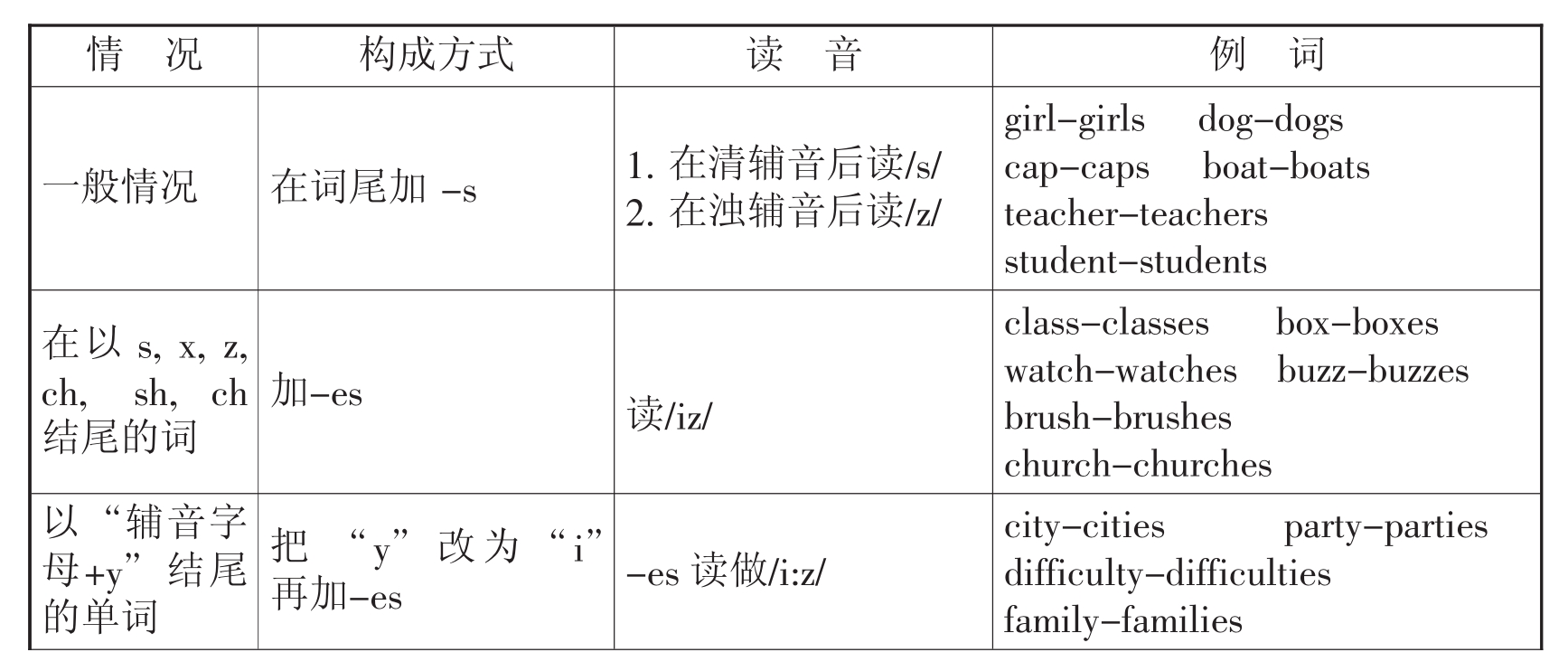
续表
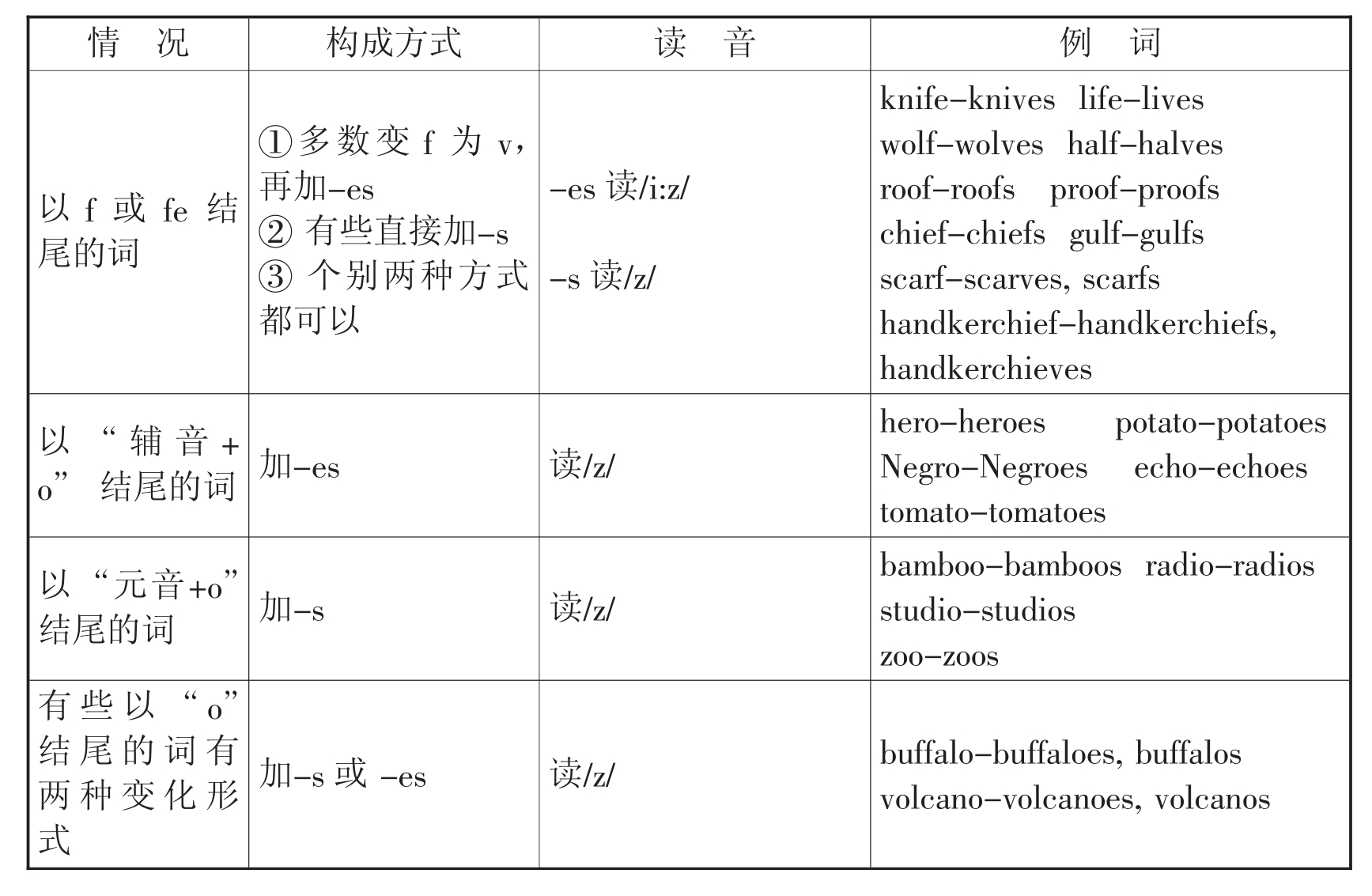
(三)复合名词变复数时的几种方式
1.以可数名词结尾的复合名词,其复数形式按最后那个词的复数变化规则来变成复数形式,如flower shop—flower shops,work room—work rooms,student dining-hall—student dining-halls等。
2.如果合成词不是完全由两个名词组成,并且组成成分中有主次之分,在变为复数时,只将主体名词变为复数。如editor-in-chief—editors-in-chief,looker-on—lookers on,grand-child—grand-children,son-in-low—sons-in-low,runner-up—runners-up(亚军),passer-by—passers-by,army-man—army-men等。
3.如果构成复合名词的组成成分无主次之分,也就是说合成词中没有主体名词,就直接在最后一个名词上加上复数词尾。如grown-up—grown-ups,go-between—go betweens,drawback—drawbacks等。
三、不可数名词的复数
不可数名词包括物质名词和抽象名词,没有复数形式,不能加-s。当不可数名词做主语时,谓语动词要用单数。常用的不可数名词有:accommodation(膳宿),abuse(虐待),accuracy(准确),advice(建议),baggage或luggage(行李),behavior(行为),bread(面包),clothing(衣服),competence(能力),copper(铜),confidence(信心),destiny(命运),dignity(尊严),energy(活力,能量),experience(经验),gold(金),iron(铁),equipment(设备),fun(乐趣),furniture(家具),harm(伤害),information(信息),knowledge(知识),leisure(闲暇),machinery(机械),money(金钱),mud(泥),news(新闻),paper(纸张),permission(允许),postage(邮资),progress(进步),lab our(劳动),popularity(声望),rain(雨水),smoke(烟),tea(茶),traffic(交通),travel(旅行),trouble(麻烦),weather(天气),appreciation(欣赏)等。
四、关于特殊名词的复数的规定
1.容易误用为复数的不可数名词(这些名词一般不能用做复数,谓语动词用单数):
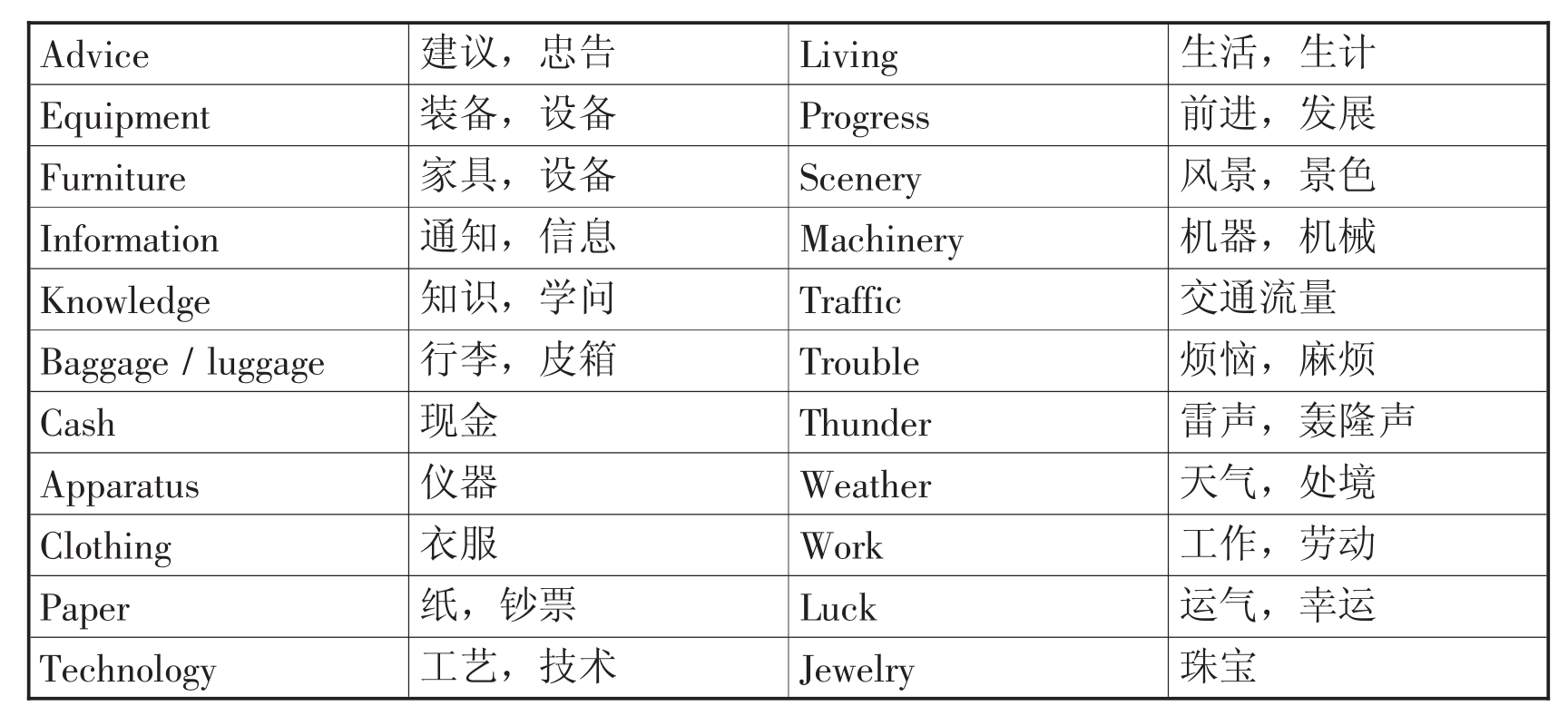
2.复数形式的名词用于单数概念,其谓语动词用单数(这些名词一般为表示学科或疾病的名词):

3.特殊复数形式的名词:

续表

4.单复数相同的名词(谓语动词视具体情况而定):

5.单数形式表示复数意义或总是用于复数的名词(谓语动词用复数):
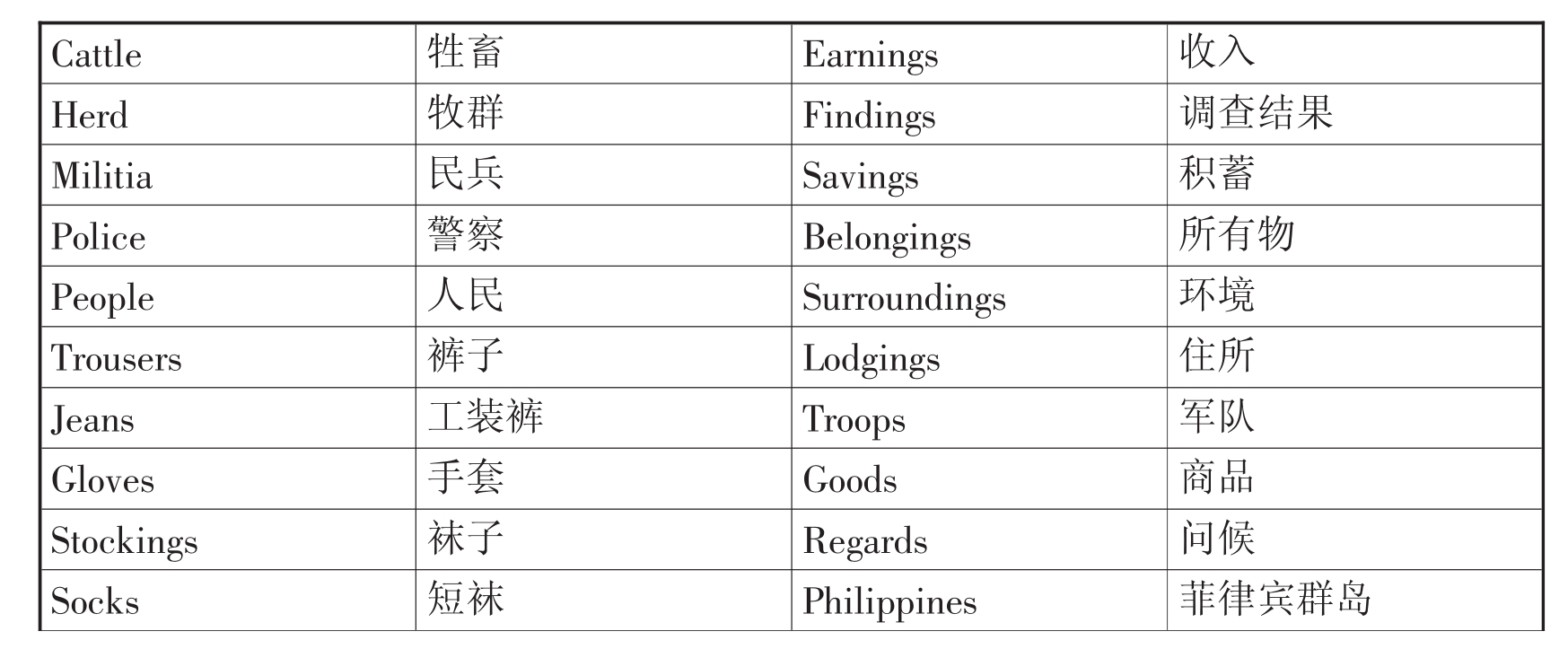
续表

6.既可用做单数又可用做复数但意义不同的名词:
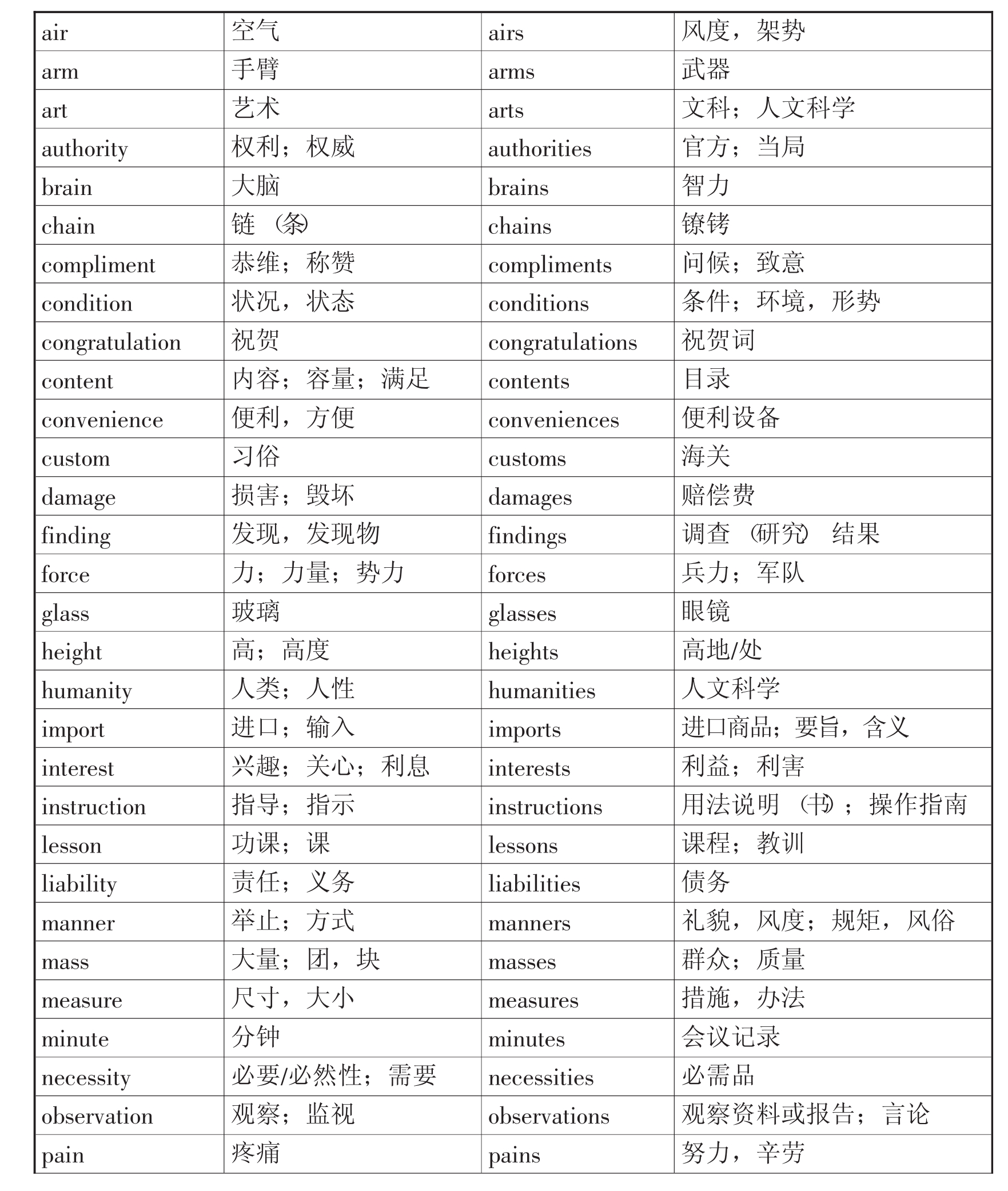
续表
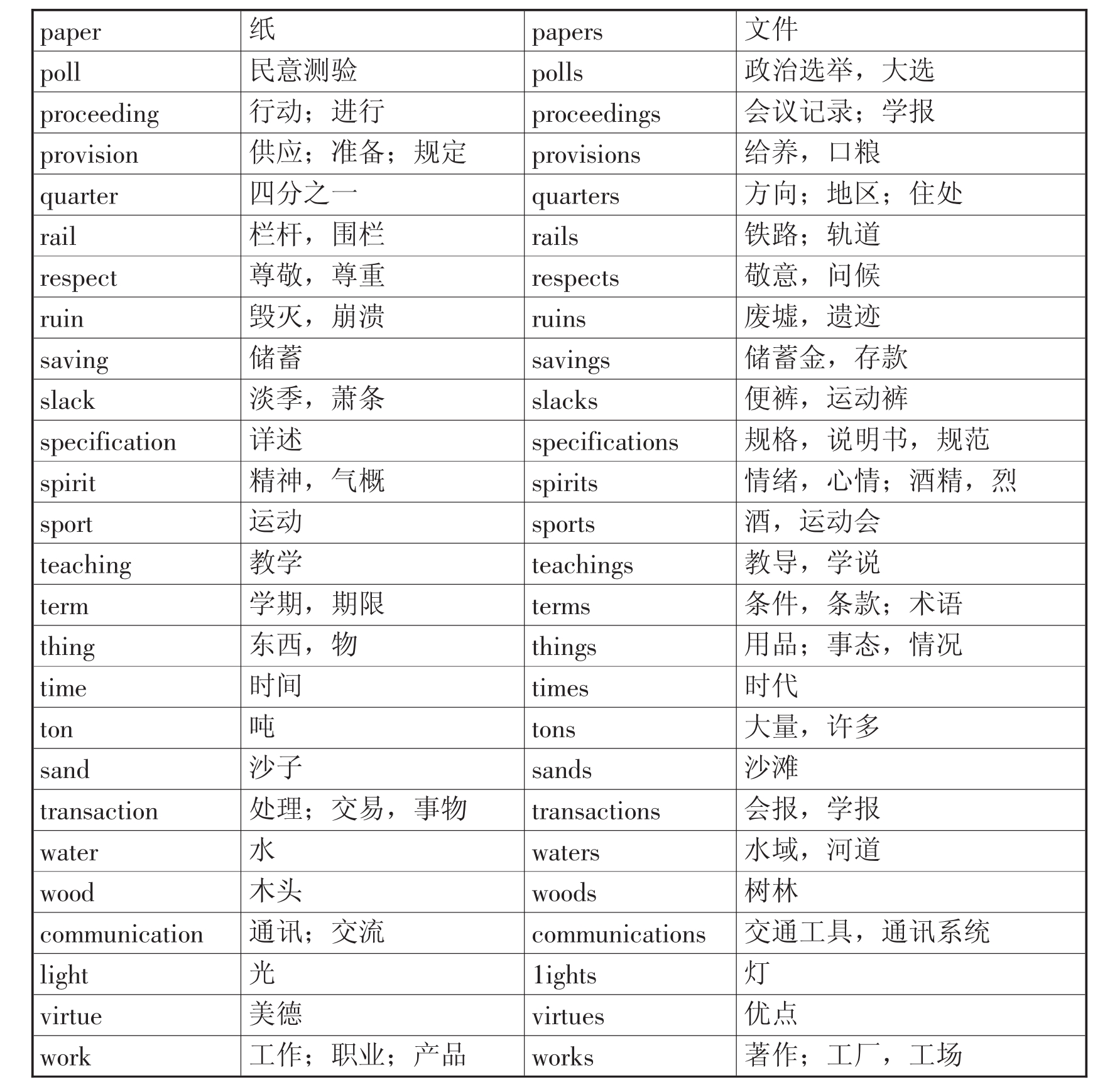
五、名词的格
英语名词有三个格:主格、宾格和所有格。主格和宾格在形式上是一样的,主要通过它在句中的作用和位置来确定,如同是student,当它在句中做主语时是主格(由主格的I,we,he,she,they等代词代表),做宾语时就是宾语(由宾格的me,us,him,her等代表)。所有格也叫属格(由my,our,her,his等代表)。这里只讲名词的所有格。
(一)名词所有格通常在名词后加“’s”构成,称为“’s所有格”
1.“’s所有格”的构成:一般是在词尾加’s(如:Mary’s room玛莉的房间,the hostess’living room女主人的起居室,my girlfriend’s telephone number我女朋友的电话号码)。如果原名词已有复数词尾-s或-es,则只加’(如:teachers’reading-room教师阅览室,students’dormitory学生宿舍)。但如果名词虽是复数,但不带-s词尾,则仍要加’s(如:the children’s grandmother孩子们的奶奶,the Working People’s Palace of Culture劳动人民文化宫)。
2.“’s所有格”主要用于表示有生命的东西的名词后面,(如:the Hunter’s Diary《猎人日记》,the chairman’s seat主席的座位,the pig’s long mouth猪的长嘴),但也可用于下面几类名词:
(1)表示时间、距离、度量及金钱的名词,如:half an hour’s walk步行半小时的路程,two dollars’worth of stamps价值两美元的邮票,two tons’weight两吨的重量。
(2)表示由人组成的集体名词,如:the delegation’s visits代表团的访问,the nation’s youngsters我国青少年,government’s policy政府政策,the company’s director公司董事。
(3)表示国家、城市、机关团体的名词,如:the country’s five-year plan国家五年计划,Beijing’s population北京的人口,China’s future中国的前景,the station’s waiting room车站候车室,the school’s history学校的历史,the industry’s geographical distribution工业布局。
3.所有格既可用来表示名词的所属关系或人们熟悉的建筑物、商店、理发店等名称,也可用人名或表示人的名词的所有格来表示某人的家。如:This is not Betty’s book,but Catherine’s.这不是贝蒂的书,而是凯瑟琳的。Have you been to St.Paul’s?你到过圣保罗教堂吗?又如:the doctor’s诊所,the Smiths’史密斯一家的住所。
4.复合名词和并列名词一般也是在词尾加’s。
(1)当复合名词变所有格时,一般是直接在词尾加’s。如:the editor-in-chief’s office总编辑室,the go-between’swords中间人的话,her daughter-in-law’s friend她儿媳的朋友等。
(2)用and连接的两个并列关系的名词,如果表示共有关系,则只在后一词尾加’s。如:During the competition of interior decoration designs,Tom and John’s incorporated design win the prize.这一设计方法是两人合伙共同完成的,是一件设计方案,所以用Tom and John’s。
(3)当and连接的两个人名表示的不是共有关系,而是各人归各人的,则在两个人名后都要加’s。如:Whenever they meet,Bill’s and David’s wives are constantly boasting their own husbands.在本句中,wife显然不应是共有的,因此要在两个人名后分别加’s。
(二)“of所有格”
1.名词所有格的第二种表示方法是由介词of加名词构成名词短语。凡是不能加’s的名词都可以与of结成短语来表示所有关系。如:the title of the song歌名,the secret of success成功秘诀,the advantage of mechanized farming机械化耕作的好处,the end of the road路的尽头。
2.“’s所有格”和“of所有格”是有区别的,我们通过对下列几个句子的比较来搞清楚二者的不同。
(1)当被修饰的名词后跟有以逗号分开的同位语时,应该用“’s所有格”结构,如:Old Flescle’s son,a vigorous Omaha leader,worked hard to make his nation a proud and progressive one。在本句中leader是son,而不是old Flescle,若用of所有格结构就刚好弄反了。
(2)当名词对后面一个表示事物的名称起分类作用时,通常要用“’s所有格”,如:Elizabeth Blackwell,the first woman who gained the medical doctor’s degree in the United States,founded the New York Infirmary,an institution that has always had a completely female medical staff.又如:children’s books儿童用书,summer’s day夏天的日子等。
(3)当定冠词加形容词或分词表示一类人时,要用“of所有格”。如:Certainly,the telephone has extended the scope of human conflicts,since it impartially disseminates the useful knowledge of scientists,and the nonsense of the ignorant,the affection of the affectionate and the malice of the malicious.句中the ignorant,the affectionate,the malicious都是用定冠词加形容词表示某一类人,它们的意思分别是“无知者”、“仁者”和“歹徒”。全句的意思是:“电话,它不偏不倚地传播科学家的真言、无知者的废话、仁者的爱心和歹徒的恶意,当然就扩大了人们之间冲突的范围。”
(4)当名词部分太长或跟有后置修饰语时,要用“of所有格”。如:No one knows the name of the girl in red standing at that gate for she never appeared around the neigh bourhood.本句所有格的意思是“站在门口身穿红衣的那位女孩的名字”。
六、双重属格(“of+名词’s”)
兼有“’s所有格”和“of所有格”的结构称为双重属格,即双重所有格。这种结构主要在下面两种情况下使用:
(1)它所修饰的词前面有一个表示数量的词(如a,two,any,some,no,few,several等),共同表示部分概念。但不能和定冠词the连用,如不能说the friends of Mary’s,而只能说Mary’s friends,或some friends of Mary’s。如:
It was no fault of the doctor’s.那不是医生的错。
Have you read any books of Dickens’?你读过狄更斯的著作吗?
Several students of Mr.Smith’s acted in the play.史密斯先生的几个学生参加了剧本的演出。
(2)它所修饰的词前面有this,that,these或those等指示代词时,句子往往包含有赞赏、厌恶等感情色彩。如:
This performance of the teachers’was wonderful.教员的这一节目真精彩。(赞叹)
That silly uncle of yours had told me the same joke three times.你那位傻叔叔已把同一个笑话给我讲了三遍了。(厌恶)
Why on earth do you like those shoes of Henry’s?你究竟为什么喜欢亨利的那双鞋呢?(不喜欢那双鞋)
七、名词所有格除了表示所有关系外,有时还可能有其他作用
(1)表示类别,如:doctor’s degree博士学位。
(2)表示同位关系,如:the city of New York纽约市。
(3)表示主谓关系,如:our teacher’s praise老师的赞扬。
(4)表示动宾关系,如:the prisoner’s release释放囚犯。
八、主谓一致关系
英语中,主语和谓语在数、性和格上应该保持一致,但在实际应用中很容易被忽视,尤其是主语和谓语之间出现插入语,故考试中经常考到主谓一致。除了以上特殊名词谓语有特殊要求外,现将主谓一致的考点归纳如下:
(1)复数原则:两个或者两个以上的名词由and连接做主语时;主语由both...and...连接时,谓语动词用复数。
Baseball and swimming are usually summer sports.棒球和游泳通常都是夏季的运动项目。
Both bread and butter are sold in that grocery.那个杂货店既卖面包,也卖黄油。
(2)就近原则:由either...or...;neither...nor...;not only...but also...;...or...;there be...等引导的主语,谓语动词的单复数取决于最靠近动词的名词的单复数。
Not only the students but also their teacher is invited to attend the party.受邀参加晚会的不仅有学生而且有教师。
(3)就远原则:主语,+as well as+另一个主语,谓语动词的单复数取决于第一个主语的名词的单复数。
My mother,as well as my two brothers,has a key to the office.
我母亲,还有我的两个哥哥都有一把办公室的钥匙。
适用于同样规定的其他结构:
with...;together with...;along with...;including...;in addition to...;besides...;except...;as much as...;accompanied by...;rather than...等。
(4)表示时间、距离、价值、量度的复数名词做主语时谓语动词用单数。
One hundred dollars is a large sum for the poor.对于穷人来说,100美元是个不小的数目。
Twenty days has passed since I met her last time.自从我上次见到她到现在已经过去二十天。(twenty days这里不做整体看待,故谓语动词用复数)
(5)and连接两个名词表示一个概念做主语时,谓语用单数;若表示的是多个不同的概念时,谓语动词用复数。
War and peace is a constant theme in literature.战争与和平是文学中永恒的主题。(War and peace是一对概念,看做一个主题)
同例:ham and eggs火腿蛋steam and bread馒头
law and order法制bread and butter面包黄油
apple pie and ice cream苹果派冰激凌folk and knife刀叉
wheel and axle轮轴needle and thread针线
love and hate爱与恨egg and rice蛋炒饭
The writer and translator is delivering a speech in our university tonight.(指同一个人)
The writer and the translator are delivering a speech in our university tonight.(指两个人)
A black and a white dog are playing in the yard.(指两只狗)
A black and white dog is playing in the yard.(指一只狗)
(6)动词不定式、动名词、名词性从句做主语时,谓语动词用单数。
Early to bed and early to rise makes one healthy,wealthy and wise.(指“早睡早起”一件事)
To work hard is necessary努力工作是很必要的。
What Is aid and did is of no concern to you.我所说的和所做的与你无关。
Reading three classical novels and making some social investigations are assignments for the students during the holiday.学生假期的任务是读3本古典小说和做社会调查。(注意:指不同性质的两件事,谓语用复数)
(7)many a,more than one+单数可数名词,尽管表示复数意义,谓语仍用单数。
Many a student has made such a mistake.很多学生都犯了这样的错误。
More than one stranger agrees with me.不止一个陌生人同意我的看法。
[注意]
在“more+复数名词+ than one”结构做主语时,谓语动词用复数。
More persons than one have been involved.卷入其中的远不止一人。
(8)由every...and every...;each...and each...;no...and no...;many a...and many a...等连接的并列主语,谓语动词用单数。
Everyman and every woman working here is getting along well with me.在这工作的所有人和我相处得都很好。
No difficulty and no hardship has discouraged him.没有什么困难或挫折可以打败他。(9)由all of,most of,half of,a lot of,part of等加名词构成的主语,谓语动词的数取决于该名词的单复数。
All of us are going to see the game.我们所有人都去看电影。
All of his time was spent on gambling.他把所有时间都花在赌博上了。
Three-fourths of the people are illiterate.3/4的人都是文盲。
同例:plenty of...,one fourth of...,none of...,some of...,majority of...,...percent of...,the rest of...,reminder of....
(10)a number of(a total of,an average of)+复数名词,谓语动词用复数。
the number of(the total of,the average of)+复数名词,谓语动词用单数。
The total of dollars donated last month was 10,000 dollars.上个月总共捐赠了1万美金。
同例:a/the variety of;a/ the group of
(11)定语从句的谓语动词注意与先行词保持一致,但注意the only one of...的用法。
One of those men likes to drive fast.这些人中有一个人喜欢开快车。
One of those men who like to drive fast is her son.这些人中喜欢开快车的那个是她的儿子。
He is the only one of those men who likes to drive fast.他是这些人中唯一喜欢开快车的。
(12)由some,any,no,every构成的复合词如somebody,nothing,nobody,anything,everybody等代词做主语时,谓语动词用单数;由each,every one,no one,either,neither,another,the other做主语时,谓语动词用单数;由either,neither,each,every修饰名词做主语时,谓语动词用单数。如:
More than one example is necessary to make the students understand this rule clearly.要想使学生清楚地理解这个问题,不只需要一个事例。
Neither is satisfactory.两个都不令人满意。
Is either of the singers reading now?两个歌手中,哪个现在正在看书?
(13)the+ adj/v-ed表示一类人时,用复数谓语动词;表示抽象概念时,谓语动词用单数。
The sick have been cured and the lost have been found.
病人得到了医治,失踪的也找回来了。
同例:the poor/dumb/innocent/guilty/unemployed/aged/oppressed/exploited...
We can do the difficult first.The impossible takes a little longer.
我们先从难题开始,不会的可能花的时间长一些。
The best is yet to come.好戏还在后头。
(14)a pair of+由两部分物体构成的名词(如:shoes,scissors,glasses,jeans,pants,trousers)做主语时,谓语动词用单数。
My new pair of pants is being altered.我的一条短裤正在修改。
(15)当主语被one(a)and a half修饰时,谓语动词用单数。
One and a half apples is left on the plate.盘子里还剩了一个半苹果。
(16)当主语由a series of...,a portion of...,a species of...,a kind of...,a sequence of...,a chain of...,a piece of...加名词(单数或复数)构成时,谓语用单数。
A series of lectures on psychology is said to be given by Mr.Li.
据说李先生会做一系列心理学方面的讲座。
A large portion of her poems was published after her death.
他的很多诗歌都是在他死后发表的。
免责声明:以上内容源自网络,版权归原作者所有,如有侵犯您的原创版权请告知,我们将尽快删除相关内容。

















